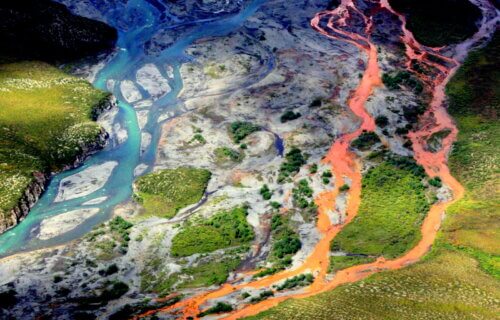ANCHORAGE — In a concerning development, researchers recently documented 75 streams across Alaska’s remote Brooks Range that have abruptly turned from clear to an alarming orange color over the past decade. This phenomenon, indicative of increased iron and toxic metal concentrations in the water, is likely linked to the rapid warming and snowfall in the region, which is causing permafrost thaw and altering the hydrology and biogeochemistry of these pristine Arctic watersheds.
Permafrost, or permanently frozen ground, acts as a natural barrier, preventing water from infiltrating deeply into the soil and keeping groundwater flow confined to shallow layers. However, as the Arctic continues to warm at an unprecedented rate, this frozen barrier is beginning to thaw, allowing water to penetrate deeper into the ground and altering the flow paths and chemistry of the water that eventually makes its way into streams and rivers.
The research team, led by Jonathan O’Donnell from the National Park Service, used a combination of remote sensing, field observations, and water sample analysis to investigate the causes and consequences of this disturbing trend. By analyzing satellite imagery from the past three decades, the researchers were able to pinpoint the timing of the color change to within the last 5-10 years, coinciding with a period of rapid warming and increased snowfall in the region. Their paper is published in Communications Earth & Environment.
“The more we flew around, we started noticing more and more orange rivers and streams,” O’Donnell, an ecologist for the NPS’ Arctic Inventory and Monitoring Network, says in a statement. “There are certain sites that look almost like a milky orange juice.

Water samples collected from the affected streams revealed significantly lower pH levels and higher concentrations of sulfate, iron, and toxic metals such as zinc, nickel, and copper compared to nearby unimpaired reference streams. The presence of these elements in the water is consistent with the weathering of sulfide minerals, which can occur when permafrost thaw exposes previously frozen mineral deposits to air and water, allowing chemical reactions to take place.
“The stained rivers are so big we can see them from space,” adds Brett Poulin, an assistant professor of environmental toxicology at UC Davis who was a principal investigator in the research. “These have to be stained a lot to pick them up from space.”
The consequences of this sudden shift in water chemistry are far-reaching and potentially devastating for the delicate Arctic ecosystem. The researchers observed a dramatic decline in the diversity of aquatic insects and a complete absence of fish in a tributary of the Akillik River in Kobuk Valley National Park just one year after the water turned orange. The accumulation of iron and toxic metals in the water can directly harm aquatic life by damaging gills, impairing growth, and reducing survival rates.
Beyond the immediate impacts on the ecosystem, the discoloration of these streams also poses a significant threat to the human communities that rely on them. Many of the affected streams are located in the traditional territories of Alaska Native peoples and are important sources of drinking water and subsistence fisheries. While the tested water samples did not exceed U.S. EPA drinking water criteria for arsenic and lead, concentrations of cadmium, nickel, and manganese were found to be above recommended levels, raising concerns about the safety of these vital water sources.
As the Arctic continues to warm and permafrost thaw accelerates, it is likely that more streams and rivers will be impacted by the mobilization of iron and toxic metals. This study highlights the urgent need for increased monitoring and research to better understand the extent and long-term consequences of this emerging threat to Arctic ecosystems and the communities that depend on them. It also underscores the importance of global efforts to mitigate climate change and protect these fragile environments for future generations.
“There’s a lot of implications,” O’Donnell says. “As the climate continues to warm, we would expect permafrost to continue to thaw and so wherever there are these types of minerals, there’s potential for streams to be turning orange and becoming degraded in terms of water quality. I think there will be a lot more detailed work to follow up to address some of the uncertainties that we currently have.”
As the permafrost continues to thaw, releasing not only greenhouse gases but also toxic elements into the environment, it is becoming increasingly clear that the impacts of climate change are not limited to rising sea levels and more frequent extreme weather events. The health and well-being of entire ecosystems and human communities are at stake, and swift action is needed to address this growing crisis.
